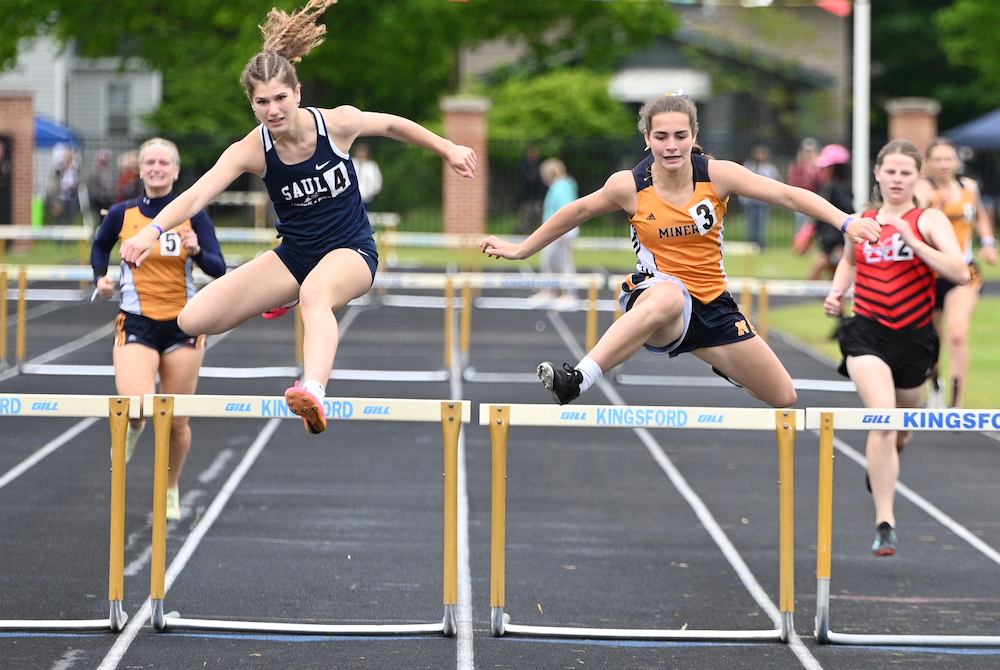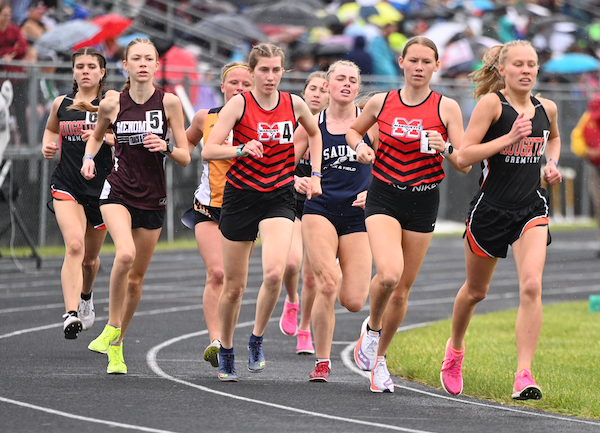
Classes Still Create Hoosier Hysteria
July 27, 2017
By Rob Kaminski
MHSAA benchmarks editor
This is the fourth part in a series on MHSAA tournament classification, past and present, that will be published over the next two weeks. This series originally ran in this spring's edition of MHSAA benchmarks.
Twenty years ago, Bloomington North High School won the Indiana High School Athletic Association boys basketball championship, defeating Delta 75-54 at the RCA Dome in Indianapolis.
The date, March 22, 1997, is at the same time revered and disdained by traditionalists in the state who saw it as the last schoolboy championship game the state would ever host.
That’s how devout the game of basketball, particularly interscholastic basketball, had become in the Hoosier state during the 87 years a state champion – one state champion, to be precise – was crowned.
Following that 1997 season, the IHSAA moved to a four-class system for its roundball tournaments, like so many of its state association counterparts had done years earlier.
It would be shocking to find more than a small percentage of current high school basketball players around the country unfamiliar with the iconic movie Hoosiers, even though the film is now more than 30 years old.
And, the storyline for that blockbuster unfolded more than 30 years prior to its release, when small-town, undermanned Milan High School defeated Muncie Central High School 32-30 in the 1954 IHSAA title game.
Perhaps it’s because of the David vs Goliath notion, or the fame of the movie that replaced Milan with the fictional Hickory and real-life star Bobby Plump with Hollywood hero Jimmy Chitwood, or the simple fact that Indiana had something other states didn’t.
Whatever the reason, plenty of opposition remains to this day to basketball classification in the state.
The fact is, the small rural schools were regularly being beaten handily by the much larger suburban and city schools as the tournament progressed each season.
Small schools also were closing at a rapid rate following the state’s School Reorganization Act in 1959, as students converged on larger, centralized county schools. From 1960 to 2000, the number of schools entering the tournament dropped from 694 to 381, and in 1997 a total of 382 schools and 4,584 athletes began competition at the Sectional level (the first level of the IHSAA Basketball Tournament).
It was at the entry level of the tournament where school administrators felt the pain of the new class system, but not necessarily for the same nostalgic reasons as the fans who either attended or boycotted the tournament.
At the Sectional round of the tournament, the IHSAA was culling just 2 percent of the revenue, with the participating schools splitting the balance. So, when Sectional attendance dropped by 14 percent in that first year of class basketball, many schools realized a financial loss. It was money they had grown to count on in prior years to help fund various aspects of the department.
Schools cumulatively received more than $900,000 from Sectional competition in 1998, but that total was down from more than $1 million in the last year of the single-class tournament.
Yet, the current format provides a great deal more opportunity and realistic chances at championship runs for schools of all enrollments.
To date, 60 additional teams have championship or runner-up trophies on display in school trophy cases around Indiana.
That was the mission in front of then-IHSAA commissioner Bob Gardner (now National Federation executive director) once the board made its decision: to give thousands more student-athletes the opportunity for once-in-a-lifetime experiences.
As any statistician knows, figures can be manipulated to tell any side of a story. Declining attendance in year one of class basketball is such a number.
The truth is tournament attendance had been on a steady downward spiral since its peak of just over 1.5 million in 1962. By the last single-class event in 1997, the total attendance was half that.
The challenge then and today, as it is for all state associations, is to find that delicate balance for those holding onto tradition, those holding onto trophies, and the number of trophies to hand out.
Editor’s Note: Stories from the Fort Wayne Journal Gazette in 1998 and from a 2007 issue of Indianapolis Monthly provided facts in this article.

Sault Ste. Marie Girls End 23-Year Championship Wait with UPD1 Win
By
John Vrancic
Special for MHSAA.com
June 2, 2024
KINGSFORD — The Sault Ste. Marie girls made a statement here Saturday while earning their first Upper Peninsula Division 1 Track & Field Finals title since 2001.
Sault scored 117 points, followed by Negaunee with 94 and Gladstone at 65.
The Blue Devils placed 1-2 in discus, won by senior Katie Anderson at 115 feet, 3 inches, with junior Annabelle Fazzari uncorking a runner-up toss of 101. Freshman Ahnaka Oshelski added a first in the 300 hurdles in 48.29 seconds, followed by Negaunee freshman Sadie Rogers (48.30) and Marquette freshman Chloe Jackson (49.56).
Oshelski also helped the Blue Devils take the 800 relay (1:49.55).
“Our handoffs were a little rough, but I just ran as fast as I could (in the 800),” freshman Grace Mayer said. “It feels great to come away as U.P. champions.”
Mayer was also part of the winning 1,600 relay, clocked at 4:17.4.
Fazzari provided the Blue Devils with a second place in the 100 hurdles (17.07) and a third in shot put (34-0).
Rogers won the 100 hurdles in 16.65 seconds, and Negaunee classmate Keira Waterman placed first in the 400 (59.23) and 800 (2:28.2).
“I didn’t really know what to expect here today,” Rogers said. “I had a good start and just pushed myself real hard. I could hear the crowd. It was very important for me to win this one. I also thought my chances in the 300 were pretty good. I knew I had to push it.”
 Gladstone set a UPD1 Finals record in the 400 relay at 50.78, shaving basically ⅓ of a second off the previous record (51.11) run by Marquette three years ago.
Gladstone set a UPD1 Finals record in the 400 relay at 50.78, shaving basically ⅓ of a second off the previous record (51.11) run by Marquette three years ago.
The Braves were led by junior Jacie Tuljus, who anchored that relay, won the 100 (12.75) and 200 (26.85) and was runner-up to Waterman in the 400 at 1:02.54.
“My starts were slow, but what we did in the 400 relay was good for today” Tuljus said. “Everybody was pretty hyped. We’re happy with it. Overall, I’m happy with the way everything went.”
Marquette sophomore Ella Fure took the 1,600 (5:31.33), followed by Houghton sophomore Tessa Rautiola (12:13.39) and Marquette junior Monet Argeropoulos (5:37.27).
Rautiola then captured the 3,200 (12:13.39), followed by Fure (12:13.46) and Argeropoulos (12:23.91)
“I just wanted to have fun and asked God to pull me through,” Fure said. “I knew if I just trusted God, He would get me through. My mom is pretty sick and couldn’t be here. I just wanted to do this for her.”
Rautiola also helped the Gremlins win the 3,200 relay in a season-best 10:10.38.
“Our school record is 10:08,” she said. “We didn’t get the record this year, although we’re absolutely happy we won. There was miscommunication in the exchange zone which created some confusion. We weren’t in the proper place for one of our handoffs. Otherwise, I think we would have had it.”
Ishpeming Westwood junior Faith Spiroff became a double winner, taking high jump (5-0) and long jump (16-4½).
Other winners were Manistique senior Danielle Lund in shot put (38-7¾) and Calumet senior Caitlyn Strom in pole vault (10-0), where she edged Westwood junior Lexi Olson on a tie-breaker. Houghton freshman Amy Sziber won the adaptive shot put, 100 and 200 events.
PHOTOS (Top) Sault Ste. Marie's Ahnaka Oshelski, left, edges Negaunee's Sadie Rogers by one hundredth of a second to capture the 300 hurdles title Saturday. (Middle) Houghton's Tessa Rautiola (2) leads the 1,600 with Marquette's Ella Fure (1) and Monet Argeropoulos (4) following close behind. Fure won the race, with Rautiola taking second. (Click for more from Cara Kamps/RunMichigan.com.)

